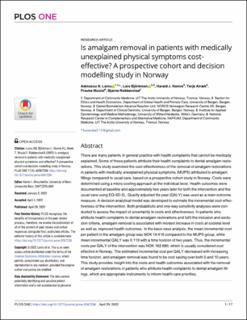| dc.contributor.author | Lamu, Admassu Nadew | |
| dc.contributor.author | Björkman, Lars | |
| dc.contributor.author | Hamre, Harald Johan | |
| dc.contributor.author | Alræk, Terje | |
| dc.contributor.author | Musial, Frauke | |
| dc.contributor.author | Robberstad, Bjarne | |
| dc.date.accessioned | 2022-08-25T07:27:37Z | |
| dc.date.available | 2022-08-25T07:27:37Z | |
| dc.date.created | 2022-08-12T09:10:16Z | |
| dc.date.issued | 2022 | |
| dc.identifier.issn | 1932-6203 | |
| dc.identifier.uri | https://hdl.handle.net/11250/3013418 | |
| dc.description.abstract | There are many patients in general practice with health complaints that cannot be medically explained. Some of these patients attribute their health complaints to dental amalgam restorations. This study examined the cost-effectiveness of the removal of amalgam restorations in patients with medically unexplained physical symptoms (MUPS) attributed to amalgam fillings compared to usual care, based on a prospective cohort study in Norway. Costs were determined using a micro-costing approach at the individual level. Health outcomes were documented at baseline and approximately two years later for both the intervention and the usual care using EQ-5D-5L. Quality adjusted life year (QALY) was used as a main outcome measure. A decision analytical model was developed to estimate the incremental cost-effectiveness of the intervention. Both probabilistic and one-way sensitivity analyses were conducted to assess the impact of uncertainty in costs and effectiveness. In patients who attribute health complaints to dental amalgam restorations and fulfil the inclusion and exclusion criteria, amalgam removal is associated with modest increase in costs at societal level as well as improved health outcomes. In the base-case analysis, the mean incremental cost per patient in the amalgam group was NOK 19 416 compared to the MUPS group, while mean incremental QALY was 0.119 with a time horizon of two years. Thus, the incremental costs per QALY of the intervention was NOK 162 680, which is usually considered cost effective in Norway. The estimated incremental cost per QALY decreased with increasing time horizon, and amalgam removal was found to be cost saving over both 5 and 10 years. This study provides insight into the costs and health outcomes associated with the removal of amalgam restorations in patients who attribute health complaints to dental amalgam fillings, which are appropriate instruments to inform health care priorities. | en_US |
| dc.language.iso | eng | en_US |
| dc.publisher | Public Library of Science | en_US |
| dc.rights | Navngivelse 4.0 Internasjonal | * |
| dc.rights.uri | http://creativecommons.org/licenses/by/4.0/deed.no | * |
| dc.title | Is amalgam removal in patients with medically unexplained physical symptoms costeffective? A prospective cohort and decision modelling study in Norway | en_US |
| dc.type | Journal article | en_US |
| dc.type | Peer reviewed | en_US |
| dc.description.version | publishedVersion | en_US |
| dc.rights.holder | Copyright 2022 Lamu et al. | en_US |
| dc.source.articlenumber | e0267236 | en_US |
| cristin.ispublished | true | |
| cristin.fulltext | original | |
| cristin.qualitycode | 1 | |
| dc.identifier.doi | 10.1371/journal.pone.0267236 | |
| dc.identifier.cristin | 2042583 | |
| dc.source.journal | PLOS ONE | en_US |
| dc.identifier.citation | PLOS ONE. 2022, 17 (4), e0267236. | en_US |
| dc.source.volume | 17 | en_US |
| dc.source.issue | 4 | en_US |

